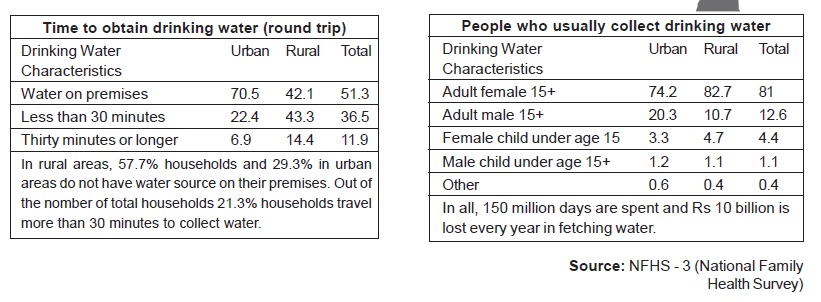|
Facts at a Glance
Gender and Water - Facts and Figures Global gender, water and sanitation scenario • For a family of six, collecting enough water for drinking, cooking and basic hygiene may mean hauling heavy water containers from a distant source for an average of three hours a day. Women and girls are mainly responsible for fetching the water that their families need for drinking, bathing, cooking and other household uses (WHO/UNICEF, 2005: 11)• Poor health resulting from inadequate water and sanitation robs the children of schooling and the adults of earning power, a situation aggravated for the women and girls by the daily chore of collecting water (WHO/UNICEF, 2005: 11)• For pregnant women, access to enough good quality water is vitally important to protect them from serious diseases such as hepatitis (WHO/UNICEF, 2005: 20)• Women face the challenge of maintaining basic household hygiene and keeping their own and their infants’ hands and bodies clean with limited water supplies, at the same time avoiding contaminating the water stored for drinking and cooking (WHO/UNICEF, 2005: 20)• Currently, in sub-Saharan Africa, a larger proportion of women are infected with HIV than their men. When women are living with HIV/AIDS, their suffering has a double impact on their families’ water problems (WHO/UNICEF, 2005: 21)• Adoption of sustainable hygiene behaviours is strongly linked to the educational level of women. Better-educated women are more likely to adopt long-term hygiene behaviour (WHO/UNICEF, 2005: 31)• Over 1.3 billion women and girls in developing countries do not have access to private, safe and sanitary toilets. In some cultural settings where basic sanitation is lacking, women and girls have to rise before dawn, making their way in the darkness to fields, railroad tracks and roadsides to defecate in the open, knowing they may risk rape or other violence in the process (WHO/UNICEF, 2004: 21)• The lack of adequate, separate sanitary facilities in schools is one of the main factors preventing girls from attending school, particularly when menstruating. Gender-sensitive school sanitation programmes can increase girls’ enrollment significantly. In Bangladesh, girls’ enrollment was increased by as much as 11% over a four-year period (UN-WWAP, 2006: 230), while in the Morocco Rural Water Supply and Sanitation Project of the World Bank school attendance in 6 provinces increased by 20% in four years. Time spent on collecting water by women and young girls was reduced by 50 to 90% (World Bank, 2003)Indian Scenario • World Bank estimates 21% of the communicable diseases in India are related to unsafe water• Diarrhoea alone causes over 1600 deaths in India every year (UNICEF 2005) q
|
